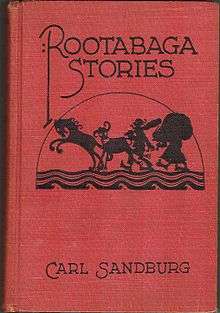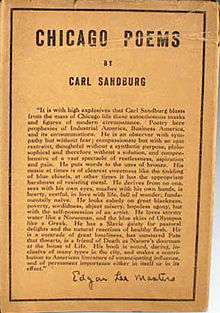Rootabaga Stories
Rootabaga Stories (1922) is a children's book of interrelated short stories by Carl Sandburg. The whimsical, sometimes melancholy stories, which often use nonsense language,[1] were originally created for his own daughters. Sandburg had three daughters, Margaret, Janet and Helga, whom he nicknamed "Spink", "Skabootch" and "Swipes", and those nicknames occur in some of his Rootabaga stories.[2]

Development
Rootabaga stories were born of Sandburg's desire to inspire intellectual freedom and curiosity within children's lives. Sandburg creates a world where children's hearts and minds can and do soar freely. Rootabaga is inspired by the magic of the American Midwest. Rootabaga country comes alive with friends such as Corn Fairies, Broom Can Handle It, Hot Dog the Tiger, and the Wind Blue Boy. In Rootabaga “the first words they speak as soon as they learn to make words shall be their names,” he said. “They shall name themselves.” That's how things go in Rootabaga, Axe me no questions, for Please Gimme don't knows-- here the windows are either open or shut, either upstairs or downstairs, just keep your eyes open and keep breathing, believing, and reading.
They explore farms, trains, sidewalks, and skyscrapers- embrace the unknown and create the impossible.[3]
Potato Face Blind Man, an old minstrel of the Village of Liver-and-Onions, hangs out in front of the local post office telling stories and is the narrative guide in Rootabaga Country.
In the Preface of the little-known Potato Face, Sandburg writes, "it is in Rootabaga Country, and in the [silliest] biggest village of that country, the Potato Face Blind Man sits with his accordion on the corner nearest the post office. There he sits with his eyes never looking out and always searching in. And sometimes he finds in himself the whole human procession."
Sequels
%2C_Frontispiece.jpg)
Rootabaga Stories was followed by a sequel, Rootabaga Pigeons, published in 1923. A little known volume of Rootabaga stories called Potato Face was published in 1930 by Harcourt, Brace and Company. It was not illustrated. A collection of previously unpublished stories was published as More Rootabagas in 1993 with illustrations by Paul O. Zelinsky.
Recordings
- TC 1089
- A vinyl LP of Carl Sandburg reading some of the stories, Rootabaga Stories as told by Carl Sandburg was released on Caedmon (TC 1089) in 1958; the cassette version is Caedmon CDL 51089.
- Description: 2s. : 331⁄3 rpm, monaural. ; 12in.
- Read by the author.
- CONTENTS. - How they broke away to go to the Rootabaga country.-How they bring back the village of cream puffs.-How the five rusty rats helped find a new village.-How six pigeons came back to hatrack the horse.-How the three wild Babylonian baboons went away in the rain.-How six umbrellas took off their straw hats to show respect.-How Googler and Gaggler, the two Christmas babies, came home.
- TC 1159 - Carl Sandburg - How to tell Corn Fairies when You see ‘Em and Others of His Rootabaga Stories
- TC 1306 - Carl Sandburg - Rootabaga Stories Vol. 3
Illustrated editions
- Never Kick a Slipper at the Moon at Google Books, illustrated by Rosanne Litzinger, 2008.
See also
- The Wonderful Wizard of Oz, another effort to devise an American fairy tale
References
- "Carl Sandburg Stops Making Sense". Poetry Foundation. 2010-01-13. Retrieved 2016-04-18.
- Harry Golden (1961). Carl Sandburg. World Pub. Co. p. 90.
- Donald Haase (2007). The Greenwood Encyclopedia of Folktales and Fairy Tales [3 Volumes]. Greenwood Publishing Group. p. 687. ISBN 9780313049477.
External links
- Rootabaga Stories [first printing, October 1922] e-text at Project Gutenberg
- Rootabaga Stories (Harcourt, Brace, 1922) at Google Books
- Carl Sandburg discography pictures of Caedmon TC 1089 LP covers, front and back
- CarlSandburg.net: A Research Website for Sandburg Studies
- Review of Rootabaga Stories and More Rootabaga Stories (Harcourt, 2003) by Georges T. Dodds at SFsite.com
- Online adaptation of the 1922 edition including illustrations
- LibriVox audio recording (Public Domain)
- Formats and Editions of Rootabaga Stories at WorldCat – catalog records from participating libraries; probably includes omnibus editions and selections published under the same title
- All "Rootabaga" titles by Carl Sandburg at WorldCat – with "view Formats and Editions" for each
- Potato Face at WorldCat
